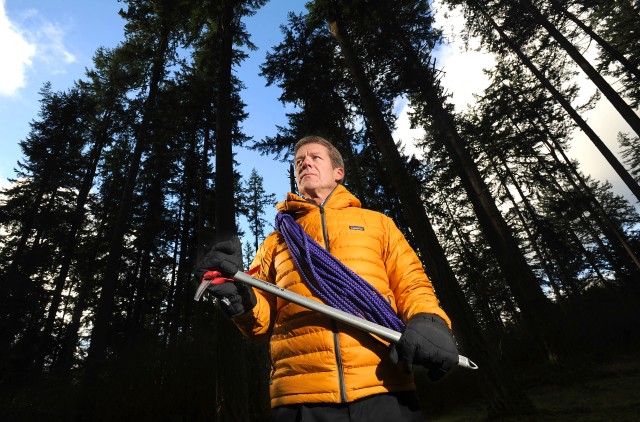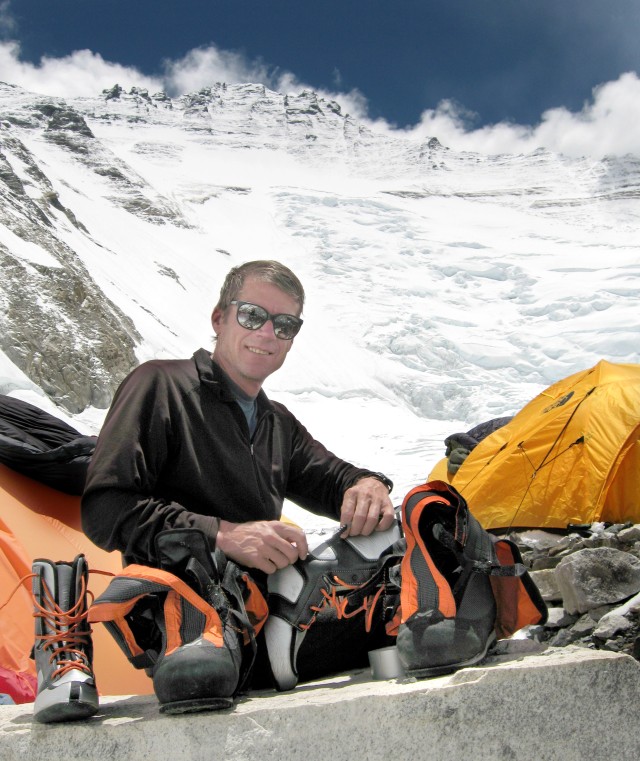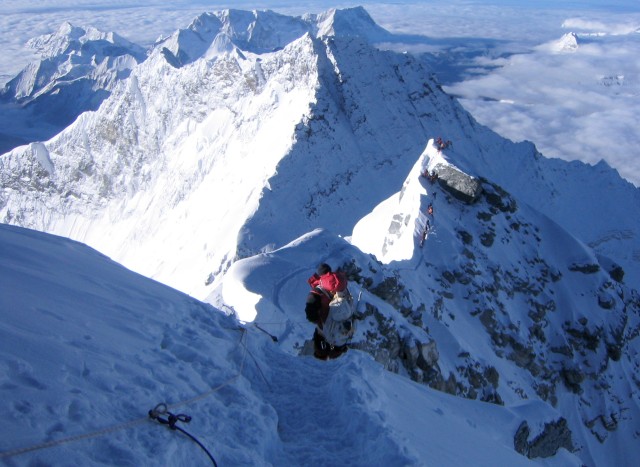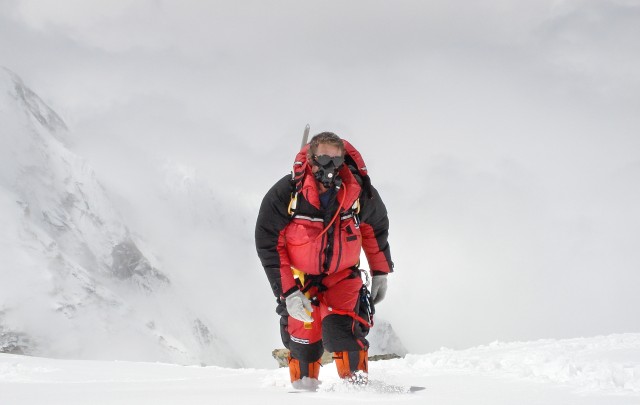JOINT BASE LEWIS-MCCHORD, Wash. -- There are few things on earth as rare as a truly perfect silence. Steve Giesecke would know.
Having summitted the highest peak on each of the world's seven continents - each on the first attempt - Giesecke has been everywhere from the equatorial jungles of Indonesia, and most recently, to the ice sheets of Antarctica.
The retired Air Force colonel returned from his final climb there only a few weeks ago. It was at Mount Vinson, on the world's most remote continent, where he experienced the most enveloping stillness he's ever known.
"When there's no wind - often there's wind - but when there's no wind, it's the quietest place on Earth," Giesecke said.
He found himself on a continent without a shred of development - no roads, cars, or people outside his group. The ice and snow absorbed any ambient noise around them. Even the voice of the nearest person couldn't travel far.
"You can hear your eyes blink," he said.
Like a lot of contractors at Joint Base Lewis-McChord, Giesecke spends most of his days at a desk. He works for the National Center for Telehealth and Technology, a Department of Defense office working to meet the psychological health and traumatic brain injury needs of the military community by developing and implementing technology solutions.
"I'm working on one of our initiatives that will bring the mental health programs of the DoD and VA closer together through collaboration on new technology assessment and development, in the areas of Web-based resources, social media and mobile applications," Giesecke said.
But in spite of the hours he spends in front of a computer, Giesecke's passion is pushing himself to the limit in some of the world's most inspiring locations. The result is a spectacular list of experiences - and more than a few examples of sheer determination.
Giesecke grew up in the Northwest, where hiking in the region's mountain ranges was almost a given. After college he climbed the Jungfrau in the Swiss Alps, which sparked an interest in climbing. When he joined the Air Force, he made a point of climbing mountains in the western U.S. between assignments.
Then in 1989, while stationed in Alaska, he climbed Denali, also known as Mount McKinley.
At 20,320 feet tall, Denali is the highest peak in North America and experiences some of the most severe weather in the world. In 1989 only 51 percent of climbers summitted the mountain, according to the National Parks Service. Today that number is 55 percent.
Giesecke had what he called "the usual experiences" on Denali. The weather was bad and only three of the people in his party made it to the top. At one point another group's tent was blown loose from the ridge above. Only one of the climbers made it out in time.
"It was very difficult back then," Giesecke said. "It still is very difficult, but back then things were a little bit heavier. You needed to take more time on the mountain to move the heavier equipment up."
About the same time, he read the book "Seven Summits" by Dick Bass, Frank Wells and Rick Ridgeway. Though at the time Giesecke thought the task out of reach for himself, the story of Bass and Wells, the first two men to successfully summit all seven peaks, would stick with him for years.
SETTING THE GOAL
When he retired from the Air Force a decade ago, Giesecke moved back to the Pacific Northwest, joined The Mountaineers club and started taking climbing classes. He continued climbing in the area, including summitting Mount Rainier multiple times. But Giesecke wanted a challenge that was bigger than he was. He wanted to know exactly how far he could go.
"I was in peak condition. I knew that if I was ever even going to have a shot at climbing the seven summits, any more of the seven summits, I knew it was then," Giesecke said.
In 2007 he signed up for a trip to Aconcagua on the Argentinean-Chilean border. The 22,841-foot peak is the highest outside of Asia. Giesecke told himself that if he made it to the top without any significant problems he would go straight to Nepal to climb Mount Everest. And in March of 2007 - after a U.S. pit stop just long enough to renew his passport - that's exactly what he did.
According to friend and fellow climber Gary Talcott, who grew up with Giesecke in Olympia, this level of resolve isn't out of the norm.
"He is very ambitious, goal oriented and determined to summit," Talcott said via e-mail, recalling a time when Giesecke helped him lead a group of climbers down from Mount Hood in whiteout conditions.
"It's fun to hear about his latest plans or last adventure," Talcott said. "I can just see the wheels turning."
The Everest trip took him two months.
Mount Everest is the tallest mountain above sea level in the world. A 1999 survey sponsored by the National Geographic Society puts the mountain at 29,035 feet tall, so high that its peak reaches into the lower limits of the jet stream. Sustained winds at the top can exceed 100 miles per hour. In July, the warmest month on the mountain, the average daytime temperature at the summit is -2 F. In January, the coldest month, the average is -33 F but can drop as low as -76 F.
Conditions are, in a word, extreme. Giesecke's experience was nothing less.
Among the final hurdles before reaching Everest's summit is the Cornice Traverse, a 400-foot knife-edged ridge leading to the Hillary Step. Teetering too far to the left would send a climber down 8,000 feet along the Southwest Face. A misstep to the right would result in plummeting 10,000 feet down the Kangshung Face.
It was here that the snow beneath Giesecke broke through, sending him sliding downward.
"I only fell about 20 feet, but the air beneath my boots was endless," he said.
Fortunately the anchors held, and he continued toward the top. After tackling the final obstacle, the 40-foot climb up the Hillary Step, Giesecke summited the mountain.
"I went up Everest on May 20, 2007, and that was a fantastic day," he said, "to be on top of the world."
DOWNHILL FROM EVEREST
The following year he took on Mount Elbrus (18,510 feet tall) on the border between Russia and Georgia. After that he went straight to Mount Kilimanjaro (19,340 feet tall) in Tanzania, leaving the area only two days before Russia's invasion of Georgia in the summer of 2008.
His next challenge was Carstensz Pyramid in Indonesia. Because the highest point on the continent of Australia is little more than a hike, some climbers take on the 16,500-foot peak to check Oceania off their lists.
While the climb itself includes a 2,000 foot wall climb topped by a Tyrolean traverse-a gap of air climbers cross on a rope suspended between two high points-getting there is a challenge all its own. Even reaching base camp requires a two-week trek through the jungle, days away from civilization.
According to Giesecke, it's the toughest trail he's ever been on.
"The face climb itself was actually fun," he said. "The jungle approach was a once in a lifetime thing. I wouldn't do that again."
And so, there was only one left. Mount Vinson, Antarctica's tallest peak, stands at 16,050 feet tall. But to get to it, Giesecke would have to wait.
In January he traveled to Punta Arenas, Chile. From there he planned to fly to Antarctica - but things were not as simple as he had hoped. A strike over rising fuel prices shut down the area, leaving Giesecke cut off from the last of the seven summits.
"It's challenging to accept things beyond my control," he said.
For him, waiting is the hardest part about mountain climbing - knowing that the goal is out there ahead of you, but not being able to reach out and grab it.
Giesecke was stranded in Patagonia for two weeks waiting for the strike to end. Not everyone in the group was as patient or invested. Some went home before so much as setting foot on Antarctica.
Not Giesecke.
"I'd gone all the way down to the end of South America to complete this trip," he said. "That's what I intended to do and that's what I did."
On Jan. 27, he made it to the top, finishing a journey he started in 1989.
"It's still sinking in," Giesecke said. "When I finished I came back home and I got out the book 'Seven Summits' and looked at it again."
Like explorers before him, Giesecke has been asked time and again why he does it. And really, there are countless reasons - the camaraderie of accomplishing great things with other people, the physical challenge, George Mallory's classic "Because it's there."
But for Giesecke, perhaps what it really comes down to the liberating challenge.
"I think when you're climbing it's one of the ultimate expressions of freedom," he said.
There aren't many places left with so few restraints, he said. But when he's pushing himself toward the summit of some impossibly high mountain, the only thing holding him back is how high he can climb.








Social Sharing